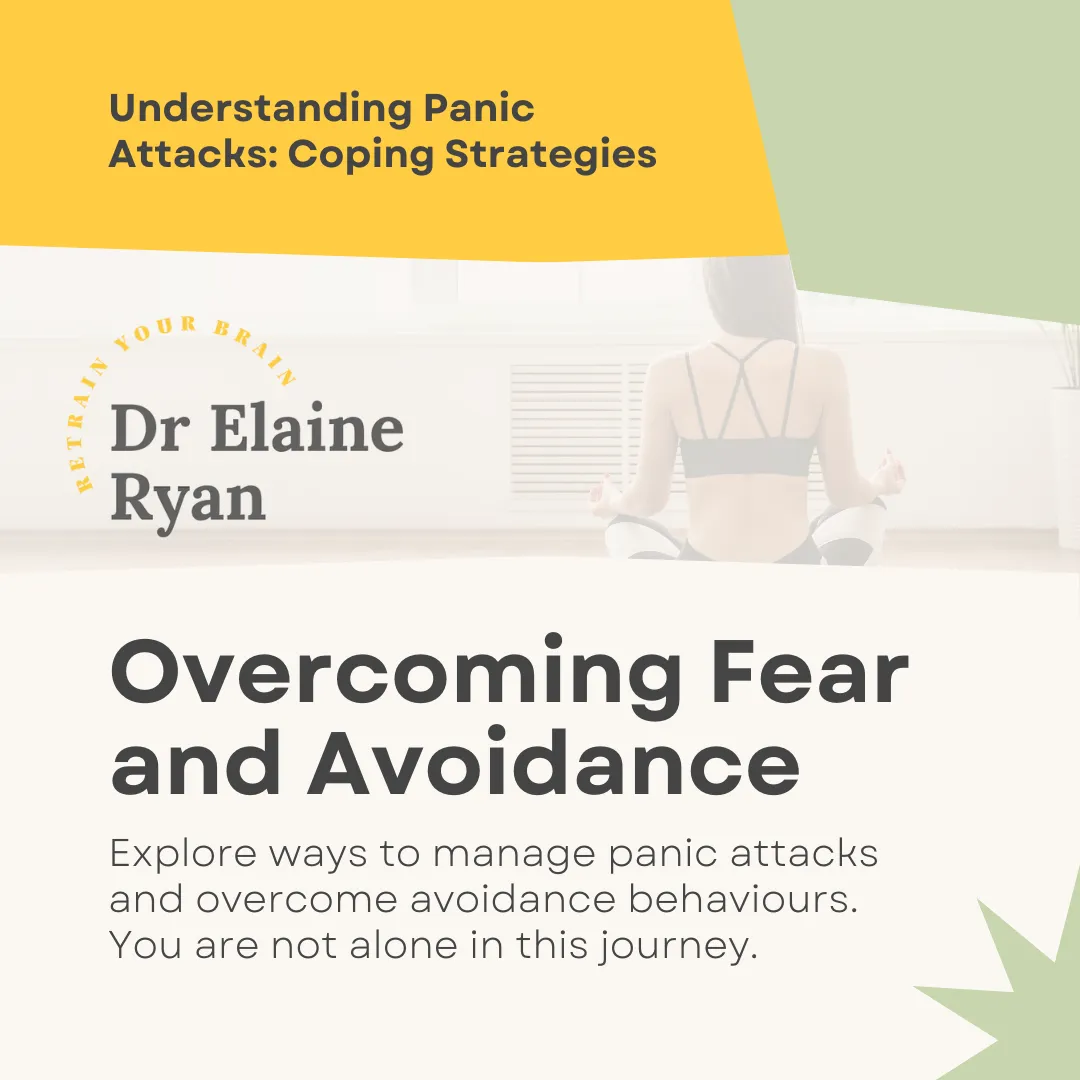Panic attacks can be a terrifying experience, and according to Mind, a type of fear response. It is understandable why you might wish to avoid things that might make you panic, but this strategy of fear and avoidance not only limits your life but also does not help you recover from panic in the long run.
The attacks can be so distressing that you go to great lengths to avoid situations you associate with panic attacks. I know I did this, not going to bed until absolutely exhausted, as my panic attacks started during my sleep. This avoidance, however, can lead to a cycle of fear and avoidance that only reinforces the panic.
Understanding this cycle is crucial for if you panic attacks. It can provide insight into the mechanisms that drive these episodes and offer a path towards effective management and treatment.
I’m going to talk today about the cycle of fear and avoidance in panic attacks, touching on psychological dynamics at play and offer strategies for breaking this cycle.
Panic Attacks Self-help

Dr Ryan’s online self-help course for Panic Attacks
Understanding Panic Attacks
Panic attacks are sudden episodes of intense fear or discomfort. They can occur unexpectedly, without any apparent trigger, or in response to specific situations or thoughts.
These attacks are not merely psychological. They often involve physical symptoms that can mimic those of serious health conditions, adding to the distress experienced by the individual. I mentioned this a few days ago when I spoke about sleep apnea, I condition I have recently been diagnosed with.
I won’t discuss the mechanism of panic attacks in depth, as it is already covered here.
Symptoms and Triggers
The symptoms of a panic attack can vary from person to person. However, common symptoms include rapid heartbeat, shortness of breath, trembling, and a feeling of impending doom.
- Rapid heartbeat
- Shortness of breath
- Trembling
- Feeling of impending doom
These symptoms can be triggered by a variety of factors. For some, they may be linked to specific situations or thoughts, while for others, they may seem to occur out of the blue. You can read more about symptoms here.
The Prevalence of Panic Disorder
Panic disorder, characterized by recurrent panic attacks, is a common mental health condition. It affects approximately 2-3% of the world wide population, and as noted by St Patrick’s we do not have official figures in Ireland, but estimated one in nine will have an anxiety disorder.
Despite its prevalence, panic disorder is often misunderstood. This lack of understanding can contribute to the stigma surrounding the condition, making it more difficult for those affected to seek help.
The Cycle of Fear in Panic Attacks
Panic attacks often trigger a cycle of fear and avoidance. The intense fear experienced during an attack can lead to a fear of future attacks. This fear can become so overwhelming that individuals begin to avoid situations or places they associate with panic attacks.
This avoidance behaviour, while intended to prevent panic attacks, can actually reinforce the fear. It can lead to a restricted lifestyle and increased anxiety, further perpetuating the cycle of fear and avoidance.
Understanding this cycle is crucial for managing panic attacks. It provides insight into the psychological mechanisms at play and can guide effective treatment strategies.
Anticipatory Anxiety and Avoidance Behavior
Anticipatory anxiety is the fear of having a panic attack. It can lead to avoidance behaviours, where individuals avoid situations or places they associate with panic attacks.
This avoidance can reinforce the fear of panic attacks. It can limit individuals’ activities and increase their overall anxiety, perpetuating the cycle of fear and avoidance.
The Role of the Amygdala
The amygdala, a part of the brain involved in fear responses, plays a key role in panic attacks. It can trigger a full-blown panic attack in response to perceived threats, even when no real danger is present.
Understanding the role of the amygdala in panic attacks can help in developing effective treatment strategies. It can provide insight into why certain situations or thoughts trigger panic attacks, and how these triggers can be managed.

Breaking the Cycle: Treatment and Management
Breaking the cycle of fear and avoidance in panic attacks often requires professional help. Treatment options include cognitive-behavioral therapy, exposure therapy, and medication; I have explained these in more detail in this article. These treatments aim to reduce the frequency and intensity of panic attacks and to help individuals manage their fear and avoidance behaviours.
It’s important to note that treatment effectiveness varies among individuals. What works for one person may not work for another. Therefore, a comprehensive and personalized treatment plan is crucial for managing panic disorder.
Cognitive-Behavioral Therapy (CBT)
Cognitive-behavioural therapy (CBT) is a common treatment for panic disorder. It helps individuals understand and change thought patterns that lead to panic attacks. By identifying and challenging these thoughts, individuals can reduce their fear and avoidance behaviours.
CBT also teaches coping strategies for managing panic attacks. These strategies can help individuals feel more in control during an attack, reducing their fear of future attacks.
Exposure Therapy: Facing Fear
Exposure therapy is another effective treatment for panic disorder. It involves gradually exposing individuals to the situations or places they fear, in a safe and controlled environment. This exposure helps individuals confront and manage their fear, rather than avoid it.
Over time, exposure therapy can reduce the fear associated with these situations or places. It can help break the cycle of fear and avoidance, leading to a less restricted lifestyle.
Medication and Panic Disorder
Medication can also be an effective treatment for panic disorder. Certain types of medication, such as selective serotonin reuptake inhibitors (SSRIs) and benzodiazepines, can help manage the symptoms of panic attacks.
However, medication is often most effective when combined with other treatments, such as CBT or exposure therapy. It’s also important to understand the potential side effects and to discuss these with a healthcare provider.
Self-Help Strategies and Coping Mechanisms
In addition to professional treatment, self-help strategies can be beneficial in managing panic disorder. These strategies can provide individuals with tools to cope with panic attacks and reduce their fear and avoidance behaviours.
Self-help strategies include relaxation techniques, lifestyle changes, and self-care practices. These strategies can help individuals feel more in control of their panic attacks and can complement professional treatment.
Relaxation Techniques and Lifestyle Changes
Relaxation techniques, such as deep breathing and mindfulness, can help manage anxiety and reduce the intensity of panic attacks. These techniques can help calm the mind and body, reducing the fear response associated with panic attacks.
Lifestyle changes, such as regular physical activity and a healthy diet, can also have a positive impact on mental health. Regular exercise can reduce anxiety, while a balanced diet can support overall brain health. Both can contribute to a reduction in the frequency and intensity of panic attacks.
Conclusion: Empowerment Through Understanding
Understanding the cycle of fear and avoidance in panic attacks is a crucial step towards managing this mental health condition. Knowledge empowers individuals to take control of their symptoms, seek appropriate treatment, and implement effective coping strategies.
In conclusion, panic attacks and panic disorder can be debilitating, but they are treatable. With the right combination of professional help, self-help strategies, and a supportive environment, individuals can break the cycle of fear and avoidance, regain control of their lives, and improve their overall quality of life.
